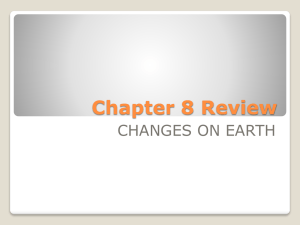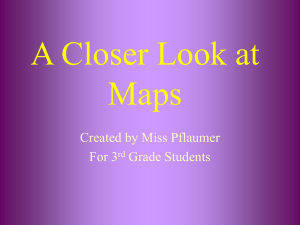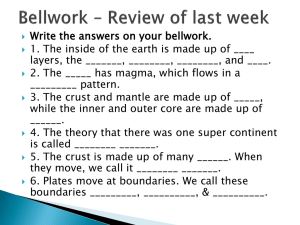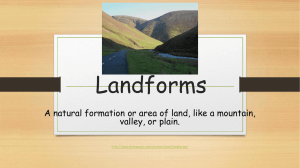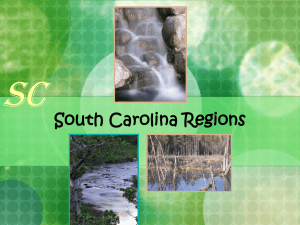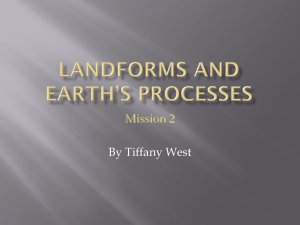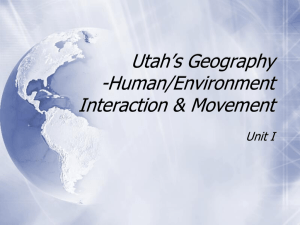LANDFORMS
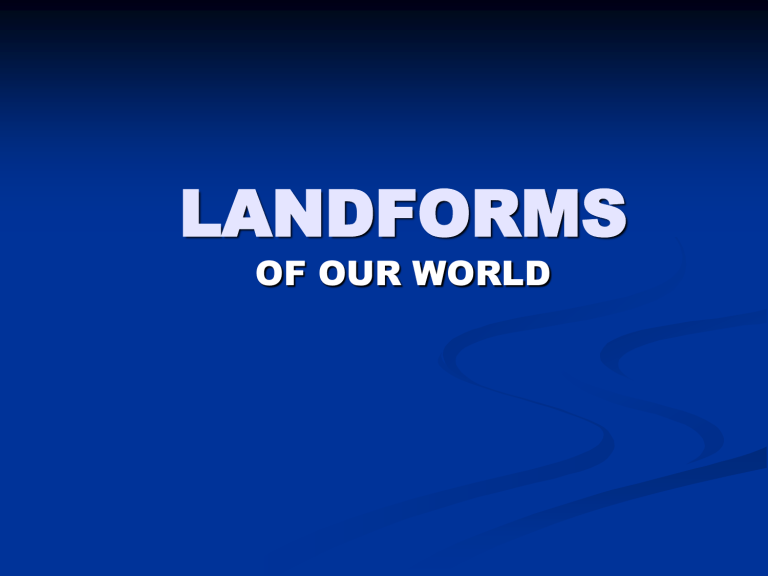
LANDFORMS
OF OUR WORLD
Earth’s Layers
Earth is divided into three layers.
The outer layer is called the crust.
Beneath the crust lies the mantle.
The core is the innermost layer
Landforms
•
The solid features formed on Earth’s crust.
•
Other features include bodies of water.
•
Crustal movement and other tectonic activity inside Earth create landforms; mountains, faults, sinks, and volcanos.
•
Many landforms are shaped by water and wind that carve and erode land surfaces, carrying and depositing soil, sand and other debris.
Topographic maps and models are used to represent landforms and help scientists better understand objects and processes.
Landforms
archipelago
ahr-kuh-pel-uh-goh
A group or chain of islands in a large body of water
Aegean Islands
bay
A bay is a body of water that is partly enclosed by land (and is usually smaller than a gulf).
The bay at San Sebastian, Spain.
A butte is a flat-topped rock or hill formation with steep sides.
butte
Butte near Sedona, Arizona.
canyon
A canyon is a deep valley with very steep sides often carved from the
Earth by a river.
View from the North Rim of the Grand
Canyon.
cape
A cape is a pointed piece of land that sticks out into a sea, ocean, lake, or river.
The Cape of Good Hope; looking towards the west, from the coastal cliffs above Cape Point.
peninsula
A peninsula is a LARGER body of land that is surrounded by water on three sides
A peninsula in Croatia.
channel
A channel is a body of water that connects two larger bodies of water
(like the English
Channel). A channel is also a part of a river or harbor that is deep enough to let ships sail through
Satellite view of the English Channel
strait and canal
Strait- A passageway of water connecting two large bodies of water.
Canal- A constructed channel filled with water used for navigation, irrigation, or drainage.
delta
A delta is a low, watery land formed at the mouth of a river. It is formed from the silt, sand and small rocks that flow downstream in the river and are deposited in the delta. A delta is often (but not always) shaped like a triangle (hence its name, delta, a Greek letter that is shaped like a triangle).
Nile River Delta
desert
A desert is a very dry area.
Erg Chebbi,
Morocco
oasis
a fertile or green area in an arid region (as a desert)
The Sahara Desert extends into southern Tunisia and covers about 40 percent of the country’s land area.
Camels are still used as a means of transportation in some parts of the desert, such as at this oasis near
Dūz
dune
A dune is a hill or a ridge made of sand. Dunes are shaped by the wind, and change all the time
Mesquite Flat Dunes in Death Valley
National Park
estuary
An estuary is where a river meets the sea or ocean.
Rio de la Plata
Estuary
fjord
A fjord is a long, narrow sea inlet that is bordered by steep cliffs.
Geirangerfjord in
Norway
geyser
A geyser is a natural hot spring that occasionally sprays water and steam above the ground.
Strokkur Geyser,
Iceland
glacier
A glacier is a slowly moving river of ice.
The Upper
Grindelwald Glacier and the Schreckhorn, in Switzerland, showing accumulation and ablation zones
gulf
A gulf is a part of the ocean (or sea) that is partly surrounded by land (it is usually larger than a bay).
Gulf of Mexico in
3D perspective.
hill
A hill is a raised area or mound of land.
The panoramic view from Connors
Hill, near Swifts Creek, Victoria
island
An island is a piece of land that is surrounded by water.
A small island in the
Adriatic Sea.
isthmus
An isthmus is a narrow strip of land connecting two larger landmasses. An isthmus has water on two sides.
The Isthmus of
Panama connects
North and South
America.
lagoon
A lagoon is a shallow body of water that is located alongside a coast.
Nearly half the area of Kiritimati is covered with lagoon, some being freshwater and some seawater.
lake
A lake is a large body of water surrounded by land on all sides. Really huge lakes are often called seas.
One of the many artificial lakes in
Arizona at sunset.
marsh
A marsh is a type of freshwater, brackish water or saltwater wetland that is found along rivers, pond, lakes and coasts. Marsh plants grow up out of the water.
Freshwater marsh in
Florida.
mesa
A mesa is a land formation with a flat area on top and steep walls - usually occurring in dry areas.
Several mesas near
Los Alamos, New
Mexico
mountain
A mountain is a very tall high, natural place on
Earth - higher than a hill. The tallest mountain on Earth is Mt. Everest.
Mount Damavand, in winter, Iran
ocean
An ocean is a large body of salt water that surrounds a continent. Oceans cover more the two-thirds of the Earth's surface
Bathymetric map of the Indian
Ocean
plain
Plains are flat lands that have only small changes in elevation
Moghan plain,
East Azarbaijan
Province, Iran
plateau
A plateau is a large, flat area of land that is higher than the surrounding land.
Monte Roraima in
Venezuela, Brazil and Guyana
pond
A pond is a small body of water surrounded by land. A pond is smaller than a lake.
A garden pond.
prairie
A prairie is a wide, relatively flat area of land that has grasses and only a few trees.
Konza Prairie in
Kansas in spring with herd of bison in distance
river
A river is a large, flowing body of water that usually empties into a sea or ocean.
Mississippi river in New Orleans
sea
A sea is a large body of salty water that is often connected to an ocean. A sea may be partly or completely surrounded by land.
Satellite image of the
Black Sea
sound
A sound is a wide inlet of the sea or ocean that is parallel to the coastline; it often separates a coastline from a nearby island
Puget Sound and Mt. Rainier of Washington
State, USA
source
A source is the beginning of a river.
River Wey near it’s source at Farringdon,
Hampshire
swamp
A swamp is a type of freshwater wetland that has spongy, muddly land and a lot of water.
Many trees and shrubs grow in swamps.
A freshwater swamp in
Florida.
tributary
A tributary is a stream or river that flows into a larger river.
The Mosel flows into the Rhein at
Koblenz.
tundra
A tundra is a cold, treeless area; it is the coldest biome.
Arctic tundra on
Wrangel Island,
Russia.
valley
A valley is a low place between mountains.
U-shaped valley in Glacier
National Park in
Montana, United States.
volcano
A volcano is a mountainous vent in the Earth's crust. When a volcano erupts, it spews out lava, ashes, and hot gases from deep inside the Earth.
Mount St. Helens in
May 1980, shortly after the eruption of
May 18.
waterfall
When a river falls off steeply, there is a waterfall.
Havasu Falls, near Supai,
Arizona, is an example of a plunge waterfall.
Ridge of sand, rock, or coral that lies at or near the surface of a sea or ocean.
reef
Pamalican island with surrounding reef, Sulu Sea,
Philippines.
savanna
An area of grassland and scattered trees.
Acacia savanna south of Fada N'Gourma, Burkina Faso.

